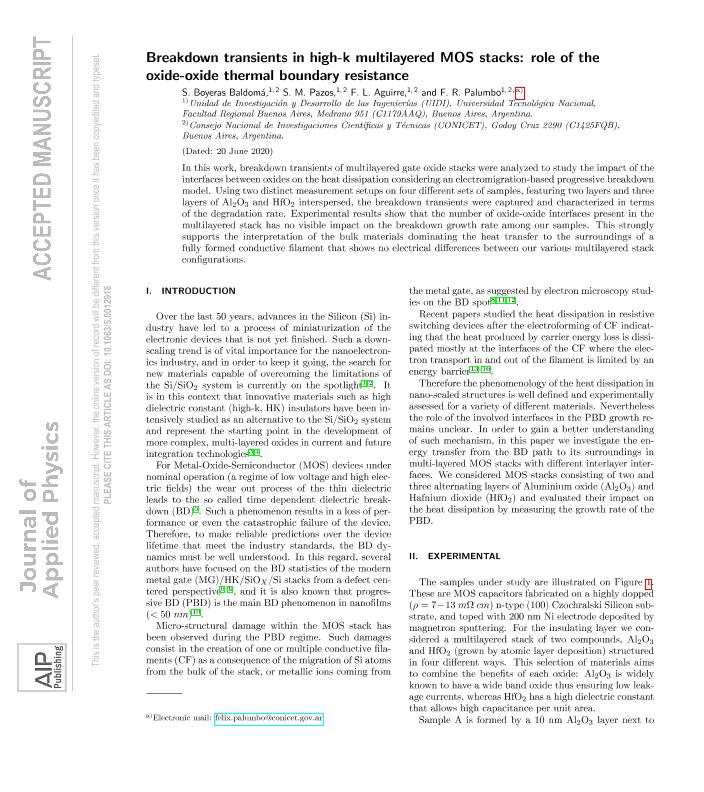Mostrar el registro sencillo del ítem
dc.contributor.author
Boyeras Baldomá, Santiago

dc.contributor.author
Pazos, Sebastián Matías

dc.contributor.author
Aguirre, F. L.
dc.contributor.author
Palumbo, Felix Roberto Mario

dc.date.available
2022-09-16T13:55:13Z
dc.date.issued
2020-07
dc.identifier.citation
Boyeras Baldomá, Santiago; Pazos, Sebastián Matías; Aguirre, F. L.; Palumbo, Felix Roberto Mario; Breakdown transients in high-k multilayered MOS stacks: Role of the oxide-oxide thermal boundary resistance; American Institute of Physics; Journal of Applied Physics; 128; 3; 7-2020; 1-9
dc.identifier.issn
0021-8979
dc.identifier.uri
http://hdl.handle.net/11336/169068
dc.description.abstract
In this work, breakdown transients of multilayered gate oxide stacks were analyzed to study the impact of the interfaces between oxides on the heat dissipation considering an electromigration-based progressive breakdown model. Using two distinct measurement setups on four different sets of samples, featuring two layers and three layers of Al 2 O 3 and HfO 2 interspersed, the breakdown transients were captured and characterized in terms of the degradation rate. Experimental results show that the number of oxide-oxide interfaces present in the multilayered stack has no visible impact on the breakdown growth rate among our samples. This strongly supports the interpretation of the bulk materials dominating the heat transfer to the surroundings of a fully formed conductive filament that shows no electrical differences between our various multilayered stack configurations.
dc.format
application/pdf
dc.language.iso
eng
dc.publisher
American Institute of Physics

dc.rights
info:eu-repo/semantics/openAccess
dc.rights.uri
https://creativecommons.org/licenses/by-nc-sa/2.5/ar/
dc.subject
RELIABILITY
dc.subject
MULTILAYERED
dc.subject
OXIDE
dc.subject
MOS
dc.subject.classification
Física de los Materiales Condensados

dc.subject.classification
Ciencias Físicas

dc.subject.classification
CIENCIAS NATURALES Y EXACTAS

dc.title
Breakdown transients in high-k multilayered MOS stacks: Role of the oxide-oxide thermal boundary resistance
dc.type
info:eu-repo/semantics/article
dc.type
info:ar-repo/semantics/artículo
dc.type
info:eu-repo/semantics/publishedVersion
dc.date.updated
2022-09-15T14:56:57Z
dc.journal.volume
128
dc.journal.number
3
dc.journal.pagination
1-9
dc.journal.pais
Estados Unidos

dc.description.fil
Fil: Boyeras Baldomá, Santiago. Universidad Tecnológica Nacional. Facultad Regional Buenos Aires. Unidad de Investigación y Desarrollo de las Ingenierías; Argentina. Consejo Nacional de Investigaciones Científicas y Técnicas; Argentina
dc.description.fil
Fil: Pazos, Sebastián Matías. Consejo Nacional de Investigaciones Científicas y Técnicas; Argentina. Universidad Tecnológica Nacional. Facultad Regional Buenos Aires. Unidad de Investigación y Desarrollo de las Ingenierías; Argentina
dc.description.fil
Fil: Aguirre, F. L.. Universidad Tecnológica Nacional. Facultad Regional Buenos Aires. Unidad de Investigación y Desarrollo de las Ingenierías; Argentina
dc.description.fil
Fil: Palumbo, Felix Roberto Mario. Universidad Tecnológica Nacional. Facultad Regional Buenos Aires. Unidad de Investigación y Desarrollo de las Ingenierías; Argentina. Consejo Nacional de Investigaciones Científicas y Técnicas; Argentina
dc.journal.title
Journal of Applied Physics

dc.relation.alternativeid
info:eu-repo/semantics/altIdentifier/url/http://aip.scitation.org/doi/10.1063/5.0012918
dc.relation.alternativeid
info:eu-repo/semantics/altIdentifier/doi/http://dx.doi.org/10.1063/5.0012918
Archivos asociados
